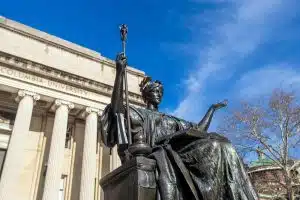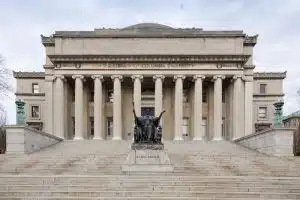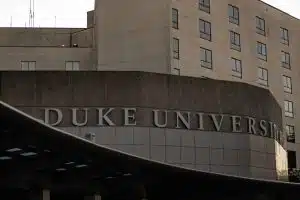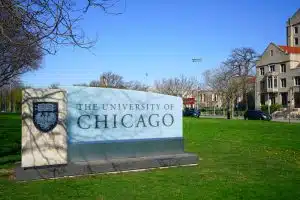The Columbia Endowment
The Columbia Endowment, a fundamental asset of Columbia University, plays a crucial role in the sustainability and development of the university’s educational and research missions. This article aims to provide a comprehensive picture of the Columbia Endowment, exploring its history, impact on the institution, approaches to investment, governance, and looking forward to its future.
Understanding the Columbia Endowment
The History of the Columbia Endowment
The Columbia Endowment traces its roots back to the 18th century when King George II of England signed the charter for King’s College, which later became Columbia University. This historic moment marked the beginning of a long and storied journey for the endowment.
Over the decades, the Columbia Endowment has significantly grown in terms of both size and role, due to a series of donations, legacies, and wise investments. Generous individuals and organizations have recognized the importance of supporting higher education and have contributed to the growth of the endowment.
Under the leadership of successive university administrations and investment personnel, the endowment has evolved into a resource that provides a substantial proportion of Columbia’s annual operating budget. This financial stability has allowed the university to thrive and continue its mission of providing a world-class education to students from all walks of life.
The Purpose and Role of the Endowment
It would be an understatement to say that the Columbia Endowment primarily exists to support the university’s operations. Rather, it is a vital resource that fuels the university’s ambition and enables Columbia to have a substantial impact on society.
The Endowment supports a broad range of activities, ensuring that Columbia remains at the forefront of innovation and academic excellence. One of the key areas where the endowment plays a crucial role is in supporting faculty salaries. By providing competitive compensation packages, the endowment attracts and retains top-notch professors who are dedicated to pushing the boundaries of knowledge and inspiring the next generation of leaders.
In addition to faculty salaries, the endowment also funds research initiatives across various disciplines. This financial support allows Columbia’s researchers to pursue groundbreaking studies, contribute to scientific advancements, and address pressing societal challenges.
Financial aid for students is another essential aspect of the endowment’s purpose. By providing scholarships and grants, the endowment ensures that talented individuals, regardless of their financial background, have the opportunity to pursue a Columbia education. This commitment to accessibility and diversity strengthens the university community and fosters a vibrant intellectual environment.
Furthermore, the endowment plays a crucial role in maintaining the university’s physical infrastructure. From preserving historic buildings to investing in state-of-the-art facilities, the endowment ensures that Columbia’s campus remains a conducive environment for learning, research, and collaboration.
Beyond these core areas, the endowment also supports numerous other programs and initiatives that enhance the overall student experience. This includes funding for student organizations, cultural events, and community engagement projects. These extracurricular opportunities enrich students’ lives and contribute to their personal and professional development.
Without the Endowment, Columbia could not maintain its standing as a global leader in higher education. The continued growth and prudent management of the endowment are essential to ensure that future generations of students can benefit from the transformative education that Columbia University offers.
The Impact of the Columbia Endowment
Influence on Columbia University
The Columbia Endowment has had a profound impact on Columbia University, shaping its academic and research landscape, fostering diversity among its student body, and enhancing its physical facilities. The financial support provided by the Endowment has directly influenced the university’s ability to maintain its academic and research quality, ensuring that Columbia remains at the forefront of innovation and intellectual advancement.
With stable and considerable financial resources, the Columbia Endowment empowers faculty and students to confidently plan for long-term projects and initiatives. This support allows researchers to delve into groundbreaking studies, explore new avenues of knowledge, and make significant contributions to their respective fields. Students, on the other hand, benefit from enhanced learning experiences, as the Endowment enables the university to offer a wide range of academic programs, cutting-edge technology, and state-of-the-art facilities.
Furthermore, the Endowment plays a crucial role in ensuring that Columbia can admit the brightest students, regardless of their financial situation. By providing robust financial aid packages, the university can attract and retain a diverse student body, fostering an environment that celebrates different perspectives, cultures, and backgrounds. This commitment to inclusivity and accessibility not only enriches the educational experience for all students but also contributes to the university’s reputation for academic excellence.
Broader Impacts on Higher Education
Beyond its influence on Columbia University, the Columbia Endowment has broader impacts on the landscape of higher education. The investment approaches and risk management strategies employed by the Endowment serve as examples for other university endowments, guiding them in their pursuit of financial sustainability and growth.
Moreover, the Columbia Endowment sets a standard for financial aid policies in higher education. By prioritizing the support of a diverse student body, the Endowment paves the way for other universities to follow suit, encouraging a more inclusive approach to admissions and financial assistance. This commitment to diversity not only benefits individual students but also contributes to the overall enrichment of the academic community, fostering a vibrant and intellectually stimulating environment.
Furthermore, the Columbia Endowment’s dedication to supporting a diverse student body sets a precedent for other universities, inspiring them to prioritize inclusivity and equity in their own admissions processes. By doing so, the Endowment not only impacts the lives of individual students but also contributes to the broader societal goal of creating a more equitable and just educational system.
Overall, the Columbia Endowment’s influence on Columbia University is far-reaching and multifaceted. From supporting academic and research endeavors to fostering diversity and inclusivity, the Endowment plays a vital role in shaping the university’s success and reputation. Moreover, its impact extends beyond the confines of Columbia, serving as a guiding light for other institutions in the realm of higher education. Through its financial support and commitment to excellence, the Columbia Endowment continues to make a lasting and positive impact on the world of academia.
The Investment Strategies of the Columbia Endowment
Overview of Investment Approach
Managing a university endowment as expansive as Columbia’s requires intricate and effective investment strategies. The university’s Investment Management Company (IMC) oversees the Endowment and aims to achieve long-term, risk-adjusted returns to support the university’s activities.
IMC uses a diversified strategy, investing in a variety of asset classes ranging from traditional holdings like stocks and bonds to alternatives such as hedge funds, private equity, and real estate.
One of the key factors in the success of Columbia’s investment approach is the deep understanding of the market dynamics and the ability to identify opportunities. The IMC team conducts extensive research and analysis to identify undervalued assets and emerging trends. This allows them to make informed investment decisions that have the potential to generate substantial returns.
Furthermore, the IMC team actively monitors the global economic and political landscape to identify potential risks and adjust the investment strategy accordingly. This proactive approach helps to mitigate potential losses and maximize returns.
Risk Management and Diversification
The primary function of IMC’s risk management strategy is not just to minimize risk but to balance risk versus potential reward. The team understands that the pursuit of higher returns inherently incorporates higher risk.
To mitigate this, IMC uses a diversified investment approach, spreading the investment across different asset classes and geographic regions. This diversification reduces the chance of catastrophic loss and increases the chances of above-average returns.
Additionally, IMC employs sophisticated risk management techniques such as portfolio optimization and hedging strategies. These techniques help to reduce the downside risk further while maintaining the potential for upside gains.
Furthermore, IMC continuously monitors the performance of each investment and conducts regular stress tests to assess the portfolio’s resilience to different market scenarios. This proactive risk management approach allows them to make timely adjustments to the portfolio, ensuring that it remains aligned with the university’s long-term goals.
Another aspect of risk management is the careful selection of investment managers. IMC thoroughly evaluates the track record, investment philosophy, and risk management practices of potential managers before allocating any funds. This rigorous due diligence process helps to ensure that the endowment’s assets are entrusted to capable and experienced professionals.
Moreover, IMC recognizes the importance of maintaining liquidity to meet the university’s financial obligations. They carefully manage the allocation of assets to ensure that there is sufficient liquidity available at all times, even during periods of market volatility.
Overall, the investment strategies of the Columbia Endowment are characterized by a comprehensive and disciplined approach. Through diversification, rigorous risk management, and active monitoring, IMC aims to generate sustainable returns that support the university’s mission and secure its financial future.
The Governance of the Columbia Endowment
The governance of the Columbia Endowment is a complex and multifaceted process that involves various stakeholders and mechanisms. At the heart of this governance structure are the Board of Trustees and the Investment Management Team (IMC), each playing a crucial role in ensuring the effective management and growth of the endowment.
The Role of the Board of Trustees
The Board of Trustees, composed of distinguished individuals from diverse backgrounds, serves as the ultimate governing body responsible for overseeing the Columbia Endowment. With their collective expertise and experience, the trustees play a critical role in setting broad investment policies that align with the overarching strategic goals of the university.
One of the primary responsibilities of the trustees is to uphold their fiduciary duty, ensuring that the endowment is managed wisely and ethically. This duty requires them to carefully consider both the current and future needs of the university, making informed decisions that will have a lasting impact on the institution.
Furthermore, the Board of Trustees actively engages with the university administration, faculty, and other stakeholders to gain insights and perspectives that inform their decision-making process. This collaborative approach ensures that the governance of the Columbia Endowment reflects the collective aspirations and values of the Columbia community.
The Investment Management Team
Supporting the Board of Trustees is the Investment Management Team (IMC), a group of highly skilled professionals dedicated to the day-to-day management of the endowment. The IMC operates with a clear mandate to implement investment strategies that align with the long-term goals of the university.
Central to the IMC’s role is the formulation and execution of asset allocation decisions. Through a meticulous and data-driven approach, the team carefully considers various factors such as market conditions, risk tolerance, and investment opportunities to determine the optimal mix of assets within the endowment portfolio.
In addition to asset allocation, the IMC actively manages relationships with external investment managers. By leveraging their extensive network and expertise, the team identifies and selects investment managers who possess the specialized knowledge necessary to maximize returns while mitigating risks.
To ensure transparency and accountability, the IMC adheres to an articulated investment strategy that undergoes rigorous monitoring and regular review. This strategy serves as a guiding framework, providing a clear roadmap for the IMC’s investment decisions and actions.
Moreover, the IMC remains vigilant in staying abreast of emerging trends and developments in the investment landscape. By continuously evaluating and adapting their strategies, the team strives to optimize the performance and growth of the Columbia Endowment, ultimately benefiting the university and its mission.
Overall, the governance of the Columbia Endowment is a collaborative and dynamic process that involves the Board of Trustees and the Investment Management Team. Through their collective efforts, the endowment is managed in a manner that aligns with the university’s strategic goals, ensuring its long-term sustainability and impact.
The Future of the Columbia Endowment
Predicted Trends and Challenges
Like any other investment entity, the Columbia Endowment faces an uncertain future impacted by broader financial trends and challenges. These include market volatility, regulatory changes, societal expectations about ethical investing, and the constant need to generate sufficient returns.
However, given its longstanding history and the rigor of its investment approach, the Endowment is well-positioned to navigate these challenges.
Potential Strategies for Growth
Looking forward, the Columbia Endowment may explore a variety of strategies for growth; these include identifying new investment opportunities, furthering diversification of the portfolio, and enhancing risk management procedures.
Moreover, the Endowment must continue its commitment to funding education and research that tackles the most pressing issues facing society. Only through continued support of Columbia’s vital work can the Endowment sustain its influential role in shaping the future.
How AdmissionSight Can Help You With College Admissions
AdmissionSight is a college consulting firm that provides personalized assistance to students throughout the college admissions process. Here are some ways that AdmissionSight can help you:
Admissions strategy: AdmissionSight can help you develop a strategic plan for your college application process. Our professional consultants can assist with identifying schools that are a good fit for your academic, extracurricular, and personal goals and help you plan and prioritize your application strategy.
Application review: AdmissionSight can review your application and provide feedback on how to improve it. We can offer suggestions on making your application stand out and highlighting your strengths and unique qualities.
Essay coaching: AdmissionSight can help you craft compelling essays that showcase your personality, goals, and achievements. We can guide you through the essay writing process and provide feedback on your drafts to help you refine your writing.
Interview preparation: AdmissionSight can provide interview coaching to help you feel confident and prepared for college interviews. Our experts can offer tips on how to present yourself professionally and how to answer common interview questions.
Extracurricular planning: AdmissionSight can help you plan and develop your extracurricular activities to make them more impactful and meaningful. We can suggest activities that align with your interests and goals and provide guidance on demonstrating your leadership and initiative.
Overall, AdmissionSight can provide valuable guidance and support throughout the college admissions process to help you maximize your chances of getting accepted into the college of your choice.
With a high success rate of over 75%, we have built a strong network in the past decade. Book an initial consultation today, free of charge!








































